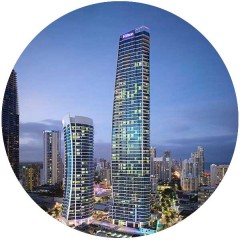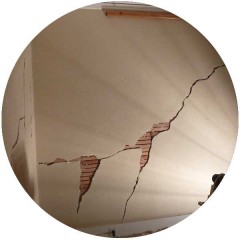Airey Taylor Consulting (ATC) has offered Expert Witness services on numerous cases of damage, collapse or failure for a full spectrum of structures, both old and new.
Peter Airey is an acknowledged forensic engineering expert on the subject of numerous causes of damage, collapse or failure of both old and new structures. He has been engaged to provide forensic engineering services in the form of an Expert Witness on numerous matters where controversy surrounds the failure of structures.
Peter Airey’s expertise is recognised as superior, particularly in the depth of knowledge he possesses of construction techniques and materials, either currently in use or used in the past. Peter is a Fellow of Engineers Australia and is a Chartered Professional Structural Engineer, practicing in his field for 55 years.
In the field of investigative structural reporting, Peter Airey has established an outstanding reputation for the high level of professionalism with which each case is approached, firstly by the scrupulous and careful investigation of evidence followed by the thorough and logical presentation of his findings. The forensic engineering facet of Peter Airey’s practice has become a major element of the practice, soon to become a separate organisation.
Peter is an experience Expert Witness in court illustrated by the case of Goldfields Homes Pty Ltd vs Blacker & Anor (1999 WADC 71) where Mr Airey was commended by the Judge for the excellence of his evidence. In many cases, the depth of his investigations has circumvented the possibility of court action and the matter has been settled out of court.
There are many reasons why a structure develops damage. Damage can be due to foundation design, a seismic event, adjacent construction, temperature effects, brick growth, incompatibility of materials, reinforcement corrosion (colloquially known as ‘concrete cancer’), roof spread, under design for terrain and wind category and of course inappropriate design and / or construction to name but a few.
Detailed analysis of structures subject to excessive vibration which do not meet design criteria, functionality and purpose are also undertaken. ATC’s team of Senior Engineer’s, together with and under the direction of Peter Airey, are able to identify deficiencies in design and collate the information into a form which can be readily understood by others not of the engineering profession i.e. legal and insurance firms.
Peter is able to identify forms of crack damage by shape and location and determine whether the cause, as claimed, is accurate.
Mr Airey’s reputation as an expert led to an invitation in 2011 to present a paper on the prevention of damage to buildings from adjoining site excavations to the WA Chapter of Engineers Australia and an invitation to present to the National conference on the topic of state of the art piling methods.
He is an acknowledged expert in restoration of heritage buildings. He is listed, as is ATC, on the directory of heritage consultants.
1998 he was accorded National recognition by his peers for development of an original system to cost effectively address ongoing damage to structures constructed on clay based soils with inadequate foundations.
Of exceptional heritage significance is the Old Farm at Strawberry Hill, Albany which illustrates the effectiveness of Peter’s system. It is a registered place with the National Trust of Australia and on the state register with the Heritage Council of Western Australia, and is protected under the heritage act. It had been repetitively damaged and repetitively repaired for the full period of its existence (circa 1827). The source of the underlying damage was clay generated movement. The aim of the restoration work for which ATC were responsible was to arrest damage occuring to the fabric of the soil beneath the building footprint, arresting damage to surgace finish due to rising damp using modern technology and conserving the building by careful rectification of the existing fabric. The conservation plan prepared made use of all the knowledge, skills and disciplines which are now available including the unique system of stabilisation of soil development patented by Peter Airey known as ‘RetroClay’. The system adopted did not impact on the visual setting or adversely affect the setting or relationships to other adjacent development. The conservation processes used contained elements of maintenance, preservation, restoration and upgrading to avoid the degrading impact of the two major factors of rising damp and clay induced damage. The conservation process went much further than pure maintenance and will conserve the structure for posterity without the annualised damage to which the building had previously been subject.
Peter is also singularly expert in the structural interpretation of geo-technical data and has advanced the status of structural engineering design within this state by the introduction of innovative and unusual foundation design for building structures to suit the relevant parameters and site constraints assembled from the geo-technical fieldwork. A well known example of this expertise can be seen in the landmark structure of the QV1 Office Tower for which is practice was awarded the ACEA Award of High Commendation for the design of pile assisted raft foundations in 1993.
In 2014 Peter was invited to be involved in drafting the National Code of Practice for Retention of Structures and Soil. This is of particular concern to Peter as he has investigated and reported on the failure of retention systems nominated by others resulting in severe damage to neighbouring properties. The building Owners are subject to undeserved personal and monetary encumbrance, finding themselves in the predicament of having to pursue the Developers of the adjacent site by engaging the services of legal firms, and who in turn require the advice of Engineers to return their property to an undamaged condition. The choice of retention systems can be readily determined, unfortunately the correct choice is often not made due to, among other things, a lack of knowledge or a reluctance to invest in a better, more appropriate system of retention.
In 1999 Peter Airey invented ‘ClayLock’ technology for design and construction of buildings over clay soil profiles. The intent of the system is to permanently stabilise at a saturated level high plasticity clay sites to prohibit the seasonal expansion and contraction of clay soils from causing damage to buildings superimposed upon them. Prototypes remaining crack free after many seasonal cycles include Dalwallinu Council Offices (2000) Class E site, Moora Hospital (2004) Class H site and Lumen Christi Performing Arts Theatre (2005) Class M site. Following successful design, construction and monitoring of the early prototypes a patent for this work first technology was granted in October 2005.
Personal injury claims for a further aspect of Peter Airey’s portfolio of investigative work. This form of investigation often involves a determination as to whether the structure, or a specific portion of the structure, complies with the Building Code of Australia and relevant Australian Standards (extant at the time of construction), and departs from same. This determination is made by onsite inspection, study of the background brief and review of the structural and architectural drawings of the building for design compliance and to determine whether or not the building, as built, complies with the design. He must also take into account modifications or alterations which may have occurred since the original construction, as laws which may have prevailed when original construction took place may differ from laws which were extant at the time of modification / alteration. An assignment of responsibility is required to be provided in order that claims can be progressed. Responsibility can often be shared and in this case a percentage is applied to the parties judged accountable.
In summation, the conclusions made after thorough investigation are reliable without bias are able to be validated and withstand the scrutiny of other Experts practicing within the same discipline. His integrity is never compromised.





